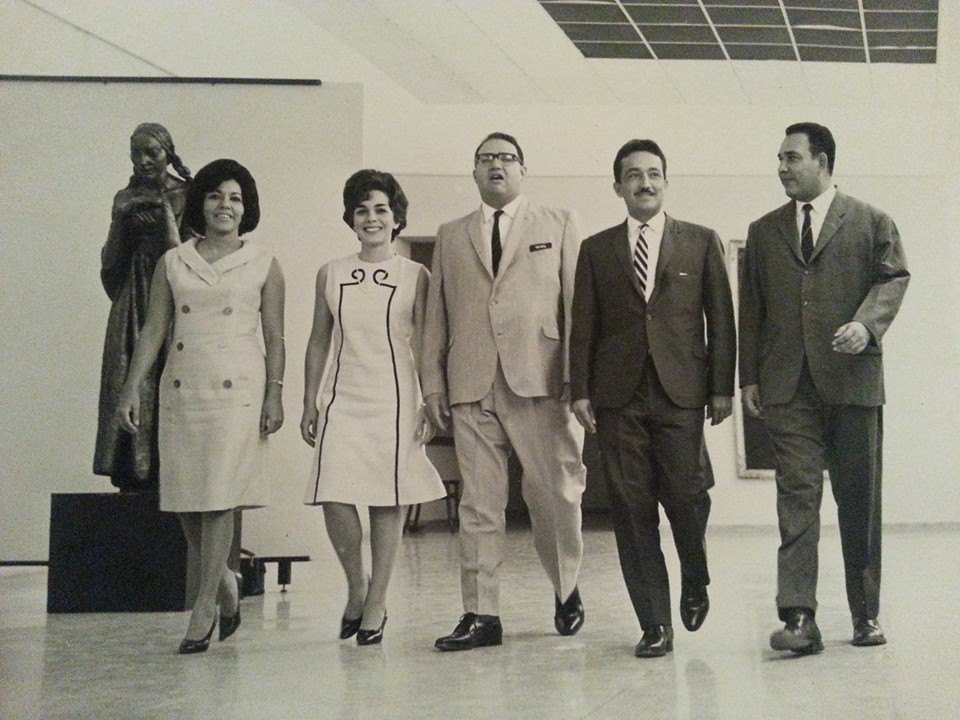Quinteto Contrapunto
Quinteto Contrapunto
Quinteto Contrapunto
March 1, 2022
March 1, 2022
The genesis of the Quinteto Contrapunto
By: Nota Marcata
By: Nota Marcata


This writing is a quote taken from the book "The Singer who Sings and Plays" (A biography of Alberto Arvelo Torrealba) written by his daughter, Mariela Arvelo. She offers a first-person account of the genesis of what later became the Quinteto Contrapunto.
Speaking of music, our home in Rome witnessed the beginnings of the Quinteto Contrapunto, or rather, the germ of the quintet, because initially there were only two members of the famous group: Rafael "Fucho" Suárez and Domingo Mendoza.
The first of them, Rafael Suárez, was a composition student at the Santa Cecilia Conservatory in Rome, and had managed to create unique musical arrangements for some popular Venezuelan corridos that my father had rescued from oblivion. Rafael then met Domingo Mendoza, a former member of the Orfeón Universitario de Caracas. Very soon, the two musicians combined their talents, entered into a fruitful harmony, conceived a new project, and ideas began to flow. Then Rafael Suárez set about writing his arrangements for two voices. Not much time passed before the duo began to interpret, in a novel and unique way, Venezuelan folk music.
Years later, at the beginning of the 60s, baritone Rafael Suárez (in his role as director, arranger, and performer of the Venezuelan cuatro), and bass Domingo Mendoza, would gather to play and sing in our home in Caracas. The initial duo was joined by the voices of mezzo-sopranos Aída Navarro and Morella Muñoz and tenor Jesús Sevillano. The Quinteto Contrapunto had been formed! Very soon, they released their first album, which achieved tremendous success.
The very name of the group, "Contrapunto," was suggested by my father, whom the musicians considered their godfather. Sometimes, as a gesture of affection towards the family, they would rehearse at the Mariela house and would offer dad a place of honor. He would make comments that the singers took into account, and he would joyfully applaud the fantastic interpretations.
Among the musical pieces of the Quinteto Contrapunto was "La Puerca," a funny popular joropo, which my father had taught them. At family gatherings, he would enjoy the humorous piece and would gracefully sing the solo of "the old woman," adapting his voice to the very trembling character:
"Muchacha, espantá esa puerca,
porque me quiere quitar la vía.
Escúchala como hace,
escúchale el ronquío,
¡Jo Jo Jo Jo!"
"Girl, scare off that pig,
because it wants to take my path.
Listen to how it sounds,
listen to its snoring,
!Jo Jo Jo Jo!"
...When the song ended, everyone would burst out laughing.
Among the other themes my father taught to Contrapunto were "Cándida María" and the "Corrido de los Pájaros." We will talk about this last composition in another chapter.
Arvelo, Mariela - "The Singer who Sings and Plays" pp 344-345.
This writing is a quote taken from the book "The Singer who Sings and Plays" (A biography of Alberto Arvelo Torrealba) written by his daughter, Mariela Arvelo. She offers a first-person account of the genesis of what later became the Quinteto Contrapunto.
Speaking of music, our home in Rome witnessed the beginnings of the Quinteto Contrapunto, or rather, the germ of the quintet, because initially there were only two members of the famous group: Rafael "Fucho" Suárez and Domingo Mendoza.
The first of them, Rafael Suárez, was a composition student at the Santa Cecilia Conservatory in Rome, and had managed to create unique musical arrangements for some popular Venezuelan corridos that my father had rescued from oblivion. Rafael then met Domingo Mendoza, a former member of the Orfeón Universitario de Caracas. Very soon, the two musicians combined their talents, entered into a fruitful harmony, conceived a new project, and ideas began to flow. Then Rafael Suárez set about writing his arrangements for two voices. Not much time passed before the duo began to interpret, in a novel and unique way, Venezuelan folk music.
Years later, at the beginning of the 60s, baritone Rafael Suárez (in his role as director, arranger, and performer of the Venezuelan cuatro), and bass Domingo Mendoza, would gather to play and sing in our home in Caracas. The initial duo was joined by the voices of mezzo-sopranos Aída Navarro and Morella Muñoz and tenor Jesús Sevillano. The Quinteto Contrapunto had been formed! Very soon, they released their first album, which achieved tremendous success.
The very name of the group, "Contrapunto," was suggested by my father, whom the musicians considered their godfather. Sometimes, as a gesture of affection towards the family, they would rehearse at the Mariela house and would offer dad a place of honor. He would make comments that the singers took into account, and he would joyfully applaud the fantastic interpretations.
Among the musical pieces of the Quinteto Contrapunto was "La Puerca," a funny popular joropo, which my father had taught them. At family gatherings, he would enjoy the humorous piece and would gracefully sing the solo of "the old woman," adapting his voice to the very trembling character:
"Muchacha, espantá esa puerca,
porque me quiere quitar la vía.
Escúchala como hace,
escúchale el ronquío,
¡Jo Jo Jo Jo!"
"Girl, scare off that pig,
because it wants to take my path.
Listen to how it sounds,
listen to its snoring,
!Jo Jo Jo Jo!"
...When the song ended, everyone would burst out laughing.
Among the other themes my father taught to Contrapunto were "Cándida María" and the "Corrido de los Pájaros." We will talk about this last composition in another chapter.
Arvelo, Mariela - "The Singer who Sings and Plays" pp 344-345.
Copyright ©
2021 -
2025
Nota Marcata.
All rights reserved.
Copyright ©
2021 -
2025
Nota Marcata.
All rights reserved.
Copyright ©
2021 -
2025
Nota Marcata.
All rights reserved.
